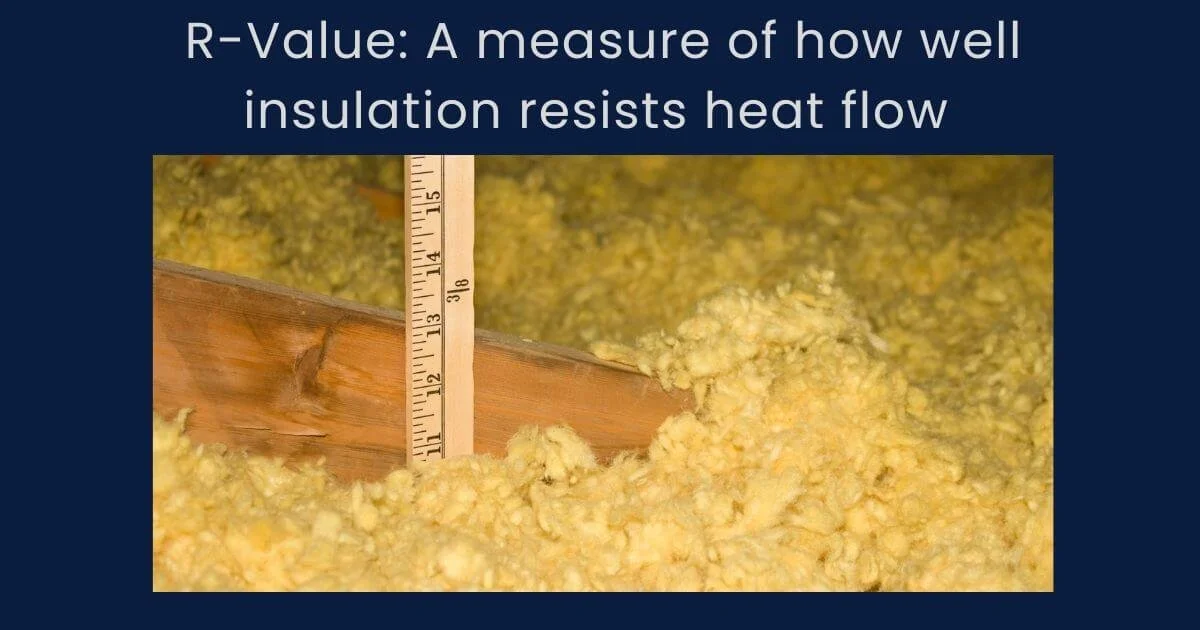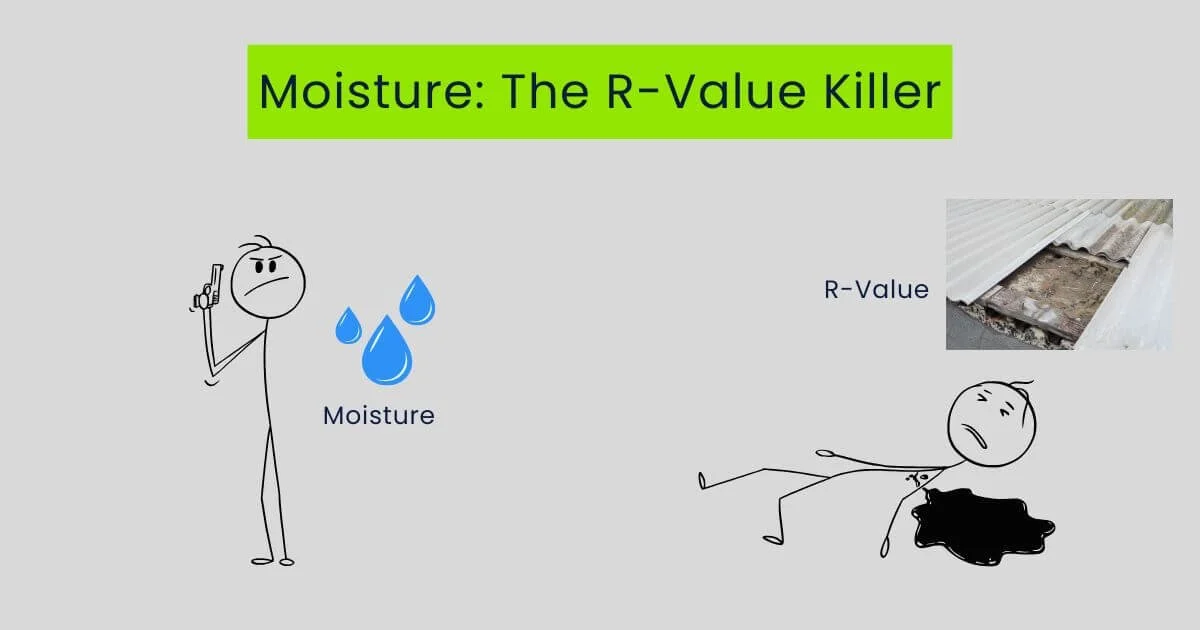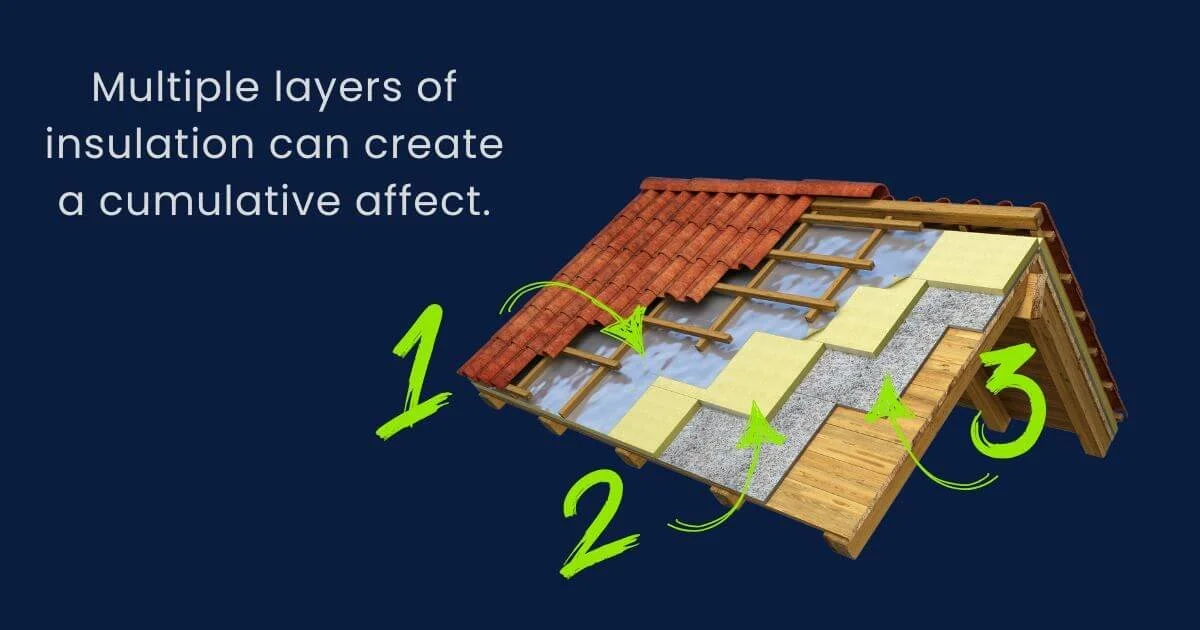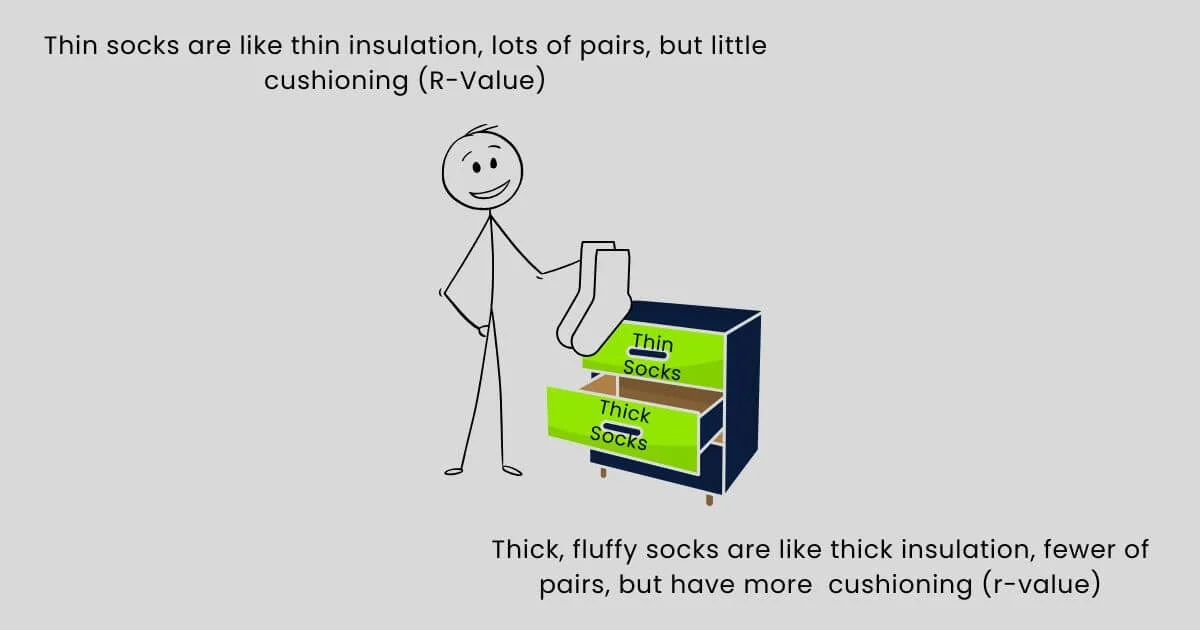R-Value Explained: Your Guide to Making Smart Insulation Choices
Is your home feeling like a freezer in winter or a sauna in summer? Are you watching your hard-earned money disappear into thin air through your heating and cooling costs? Understanding r-value might be the game-changer you've been looking for!
Let's break down this mysterious "R-Value" thing that insulation manufacturers always talk about but rarely explain in terms that make sense to the average homeowner. By the end of this post, you'll be an r-value expert, ready to make informed decisions for your insulation project!
What Exactly Is R-Value? The Foundation of Insulation Performance
R-value explained simply: it's a measure of how well insulation resists heat flow. Think of r-value as your insulation's "resistance rating." The higher the r-value, the better the insulation works at stopping heat transfer between your cozy home and the wild temperature swings outside.
Every insulating material gets assigned an r-value based on its ability to resist heat flow. When you see a label that says "R-13" or "R-19," those numbers tell you exactly how effective that product is at thermal resistance.
The Science Behind R-Value: Understanding Thermal Resistance
To really get why r-value matters, let's look at what happens without proper insulation:
In winter, the warm air in your home naturally wants to escape to the colder outside (heat loss). In summer, hot outdoor air wants to sneak inside (heat gain). Insulation's r-value quantifies how well it blocks this natural heat transfer.
The technical formula for determining r-value is: R-value = temperature difference × area × time ÷ heat loss
But don't worry about memorizing that! Just remember: higher r-value = better thermal resistance = less money spent on heating and cooling costs.
R-Value Comparisons: Different Materials, Different Performance
Let's look at how various insulation materials stack up in terms of r-value per inch:
A Fresh Take on Understanding R-Value
Think of insulation's r-value like a library's security system. Just as libraries protect books from being taken without permission, insulation protects your comfortable indoor environment from unwanted temperature exchanges.
Standard insulation (R-13) is like a basic alarm system - it does the job, but determined "heat thieves" can still get through. Higher r-value insulation (R-30 or R-38) is like having a sophisticated security system with motion detectors, cameras, and guards - much more effective at preventing heat transfer!
When you add multiple layers of insulation, you're essentially adding more security checkpoints. Each layer contributes to the total r-value, making it harder for heat to sneak in or out of your home.
Factors That Affect Your Insulation's R-Value
Even the best insulation can fall short if these factors aren't addressed:
Installation Quality Matters
Poorly installed insulation with gaps can reduce its effective r-value by up to 30%! Proper installation ensures you get the full thermal resistance you paid for.
Compression Reduces Performance
Squishing R-19 insulation into a space that only fits R-13 doesn't give you R-19 performance. Compressed insulation loses r-value because the air pockets that provide thermal resistance get squeezed out.
Thermal Bridging: The Heat Highway
Thermal bridging occurs when heat finds pathways through materials with lower r-values (like wood studs) that interrupt your insulation. This creates a parallel heat conduction path, bypassing your insulation's thermal resistance.
Moisture: The R-Value Killer
Wet insulation can lose up to 60% of its r-value! Why? Water conducts heat more efficiently than air, significantly reducing your insulation's thermal resistance.
Air Leaks: The Silent Efficiency Thieves
Even high r-value insulation won't perform well if air leaks are present. Air infiltration through cracks and gaps bypasses insulation entirely, making its r-value almost irrelevant in those spots.
Different Home Areas Need Different R-Values
Not all spaces in your home need the same level of thermal resistance. Here's what experts recommend for different areas in colder climates:
Attics: R-49 to R-60
Exterior walls: R-13 to R-21
Floors: R-25 to R-30
Basement walls: R-10 to R-19
Crawl spaces: R-19 to R-25
Remember, these recommended r-values vary by climate zone. Homes in Alaska need higher r-values than homes in Arizona!
The Ice Cream Cooler Test: How R-Value Works in Real Life
Imagine you're bringing home ice cream on a hot summer day. You have three options:
A paper bag (R-1)
A lunch box (R-5)
A premium cooler (R-15)
Which would keep your ice cream solid longest? The premium cooler, of course! That's because its higher r-value provides better resistance to heat flow.
Your home insulation works the same way. With low r-value insulation, your indoor temperature quickly moves toward the outdoor temperature - like ice cream melting in a paper bag. With high r-value insulation, your home maintains its temperature much longer - like ice cream staying frozen in a premium cooler.
R-Value and Energy Efficiency: The Money-Saving Connection
Investing in proper r-value insulation directly impacts your wallet:
Homes with inadequate insulation can lose up to 30% of their heating and cooling through walls and 25% through the attic
Adding insulation with the appropriate r-value for your climate zone can cut energy bills by 15-20%
The Department of Energy estimates proper insulation saves the average homeowner $200-$400 annually
Common R-Value Questions Answered
Is R13 or R19 better for walls?
R19 provides better thermal resistance than R13, but the choice depends on your wall cavity depth. Standard 2x4 walls typically fit R13-R15, while 2x6 walls can accommodate R19-R21. Remember, compressed insulation loses r-value, so don't force R19 into a 2x4 wall cavity!
How much better is R38 vs R30 insulation?
R38 provides about 27% more thermal resistance than R30. Is it worth the upgrade? In colder climates or for poorly insulated homes, absolutely! The increased resistance to heat flow will pay for itself through lower heating and cooling costs.
Does doubling insulation double the R-value?
Yes! Adding multiple layers of insulation creates a cumulative effect. Two layers of R19 insulation give you approximately R38 total r-value. This makes adding insulation one of the most straightforward ways to improve your home's energy efficiency.
What's considered a "good" R-value?
A "good" r-value depends entirely on:
Your climate zone
Where in the home the insulation is installed
Your energy efficiency goals
For example, in Minnesota, a "good" attic r-value might be R60, while in Texas, R38 might be perfectly adequate.
The Sock Drawer Analogy: Understanding Insulation Thickness and R-Value
Think about organizing socks in a drawer:
With one layer of socks (thin insulation), you can fit many pairs but have little cushioning (low r-value)
With thick, fluffy socks (thick insulation), you fit fewer pairs but have more cushioning (high r-value)
Insulation thickness works similarly. Different insulating materials provide different r-values per inch of thickness. Spray foam insulation delivers R6.5 per inch, while fiberglass might provide R3.5 per inch. This means spray foam can achieve higher thermal resistance in less space!
The Hidden Factors: What Insulation Manufacturers Don't Always Tell You
When comparing insulation r-values, watch out for these often-overlooked factors:
Aged R-Value vs. Initial R-Value
Some insulation materials lose r-value over time. Foam insulation typically maintains its thermal resistance better than fiberglass, which can settle and lose effectiveness.
Center-of-Cavity R-Value vs. Clear-Wall R-Value
Insulation manufacturers often advertise the "center-of-cavity" r-value, which doesn't account for thermal bridging through studs. The "clear-wall" r-value includes the effects of framing and gives a more realistic picture of overall thermal resistance.
Installed R-Value vs. Labeled R-Value
The r-value on the package assumes perfect installation. In reality, insulation installed by inexperienced DIYers often performs below its rated thermal resistance due to gaps, compression, and improper fitting.
Continuous Insulation: The Gold Standard for Thermal Resistance
To maximize r-value and minimize thermal bridging, many energy-efficient homes use continuous insulation - an uninterrupted layer of insulating material that covers the entire building envelope, including studs and joists.
This approach dramatically improves the overall r-value of your walls by eliminating those parallel heat conduction paths that bypass traditional insulation.
Beyond R-Value: Other Insulation Properties to Consider
While r-value measures resistance to heat flow, other factors also matter when choosing insulation:
Air Sealing Capability
Some insulating materials, like spray foam insulation, seal air leaks while providing thermal resistance. Others, like fiberglass batts, do little to stop air infiltration unless paired with a separate air barrier.
Moisture Management
Different insulation materials handle moisture differently. Some, like closed-cell spray foam, act as vapor barriers. Others, like cellulose, are more vulnerable to moisture problems.
Sound Dampening
Higher density insulation materials often provide better sound insulation in addition to thermal resistance, giving you a quieter home.
Climate-Specific R-Value Recommendations
Your climate zone determines how much insulation you need. Let's look at recommended r-values for different regions:
Cold Climates (Zones 5-8)
Attics: R49-R60
Walls: R13-R21 (plus R5-R6 continuous insulation)
Floors: R25-R30
Mixed Climates (Zones 3-4)
Attics: R38-R49
Walls: R13-R15 (plus R2.5-R5 continuous insulation)
Floors: R19-R25
Hot Climates (Zones 1-2)
Attics: R30-R38
Walls: R13-R15
Floors: R13
The Airplane Analogy: Why R-Value Distribution Matters
Think of your home like an airplane with first-class, business, and economy sections. Just as airlines allocate different amounts of space and comfort to different areas, you should distribute your insulation r-values strategically throughout your home.
Your attic (first class) deserves the highest r-value since it's where most heat loss/gain occurs. Exterior walls (business class) need moderate r-values. Interior walls (economy) need minimal or no insulation for thermal purposes.
This strategic distribution of r-values maximizes your insulation budget and overall energy efficiency.
DIY vs. Professional Installation: Impact on Real-World R-Value
The way insulation is installed dramatically affects its actual thermal resistance:
The DIY Reality Check
Meet Tim, who decided to insulate his attic himself. He bought R30 insulation but installed it with these common mistakes:
Gaps around electrical boxes
Compressed insulation around pipes
Uneven coverage with some areas having less than intended thickness
Result? Despite paying for R30, his effective r-value was closer to R22 - a 27% loss in thermal resistance and energy efficiency!
The Professional Advantage
Compare that to Sarah, who hired pros to install the same R30 insulation:
Complete coverage with no gaps
Proper installation thickness maintained
Attention to often-missed areas like attic hatches and recessed lights
Result? Sarah got the full R30 value she paid for, maximizing her resistance to heat flow and energy savings.
Final Thoughts: Making Smart R-Value Choices
Understanding r-value is about more than just buying the highest number your budget allows. It's about:
Matching the right r-value to your climate zone and specific home areas
Ensuring proper installation to achieve the full thermal resistance
Addressing thermal bridging, air leaks, and moisture issues
Considering the overall insulation system, not just individual components
Remember, the goal isn't just higher r-values – it's creating a comfortable indoor environment while minimizing heating and cooling costs.
Ready to improve your home's insulation's r-value? Give Argyle Bros Insulation a call! Our team of experts can assess your current insulation, recommend optimal r-values for your specific situation, and install high-performance insulation that actually delivers the thermal resistance you're paying for.
Because when it comes to r-value, don't just take the number on the package at face value - make sure you're getting the real-world performance you deserve!








